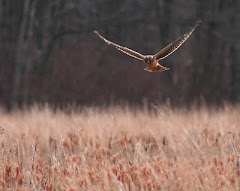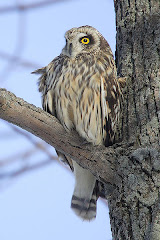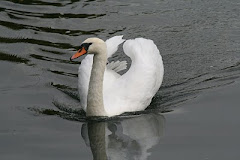
Watching wildlife is not all joy and excitement. There are moments of shock and sadness, too, yet even these moments contribute to the fascination. The death of one of ‘our’ adult barn owls meant there was to be no repeat of the owl watching experiences of the previous two years, but the presence of the surviving partner throughout the summer and autumn gave me hope that things would soon return to normal. As an optimist I had clung to the words of Matthew Twigg of the ‘Barn Owl Trust’: “a site that is attractive to one (pair of) Barn Owl(s) is likely to be attractive to the species as a whole, and there is always the chance that a similarly unpaired individual may be looking for a mate”.
The New Year repaid my optimism, and by early January 2010 we saw two barn owls entering and leaving the garage. A new mate had been found!
There was to be another sad sight, though, before the winter was over. After a particularly cold spell, I was tidying the garden in mid-January and took a look inside the garage – or rather an open out-building in which we could park the car if we ever cleared out all the junk. On the floor in the corner was the body of a bird - but not just any bird. This was a bird of prey, with a large, hooked beak and huge talons at the end of its long yellow legs. Viewed at a distance (and I had seen one on only three previous occasions), identification can be difficult, but this close it took me only seconds – it was a Peregrine Falcon, the fastest animal on Earth.
Its eyes were sunken, and it seemed to have very little flesh under its feathers. Around its left leg was an alloy ring with clear lettering. It identified the ring as having originated at the Zoological department of the University of Helsinki, in Finland. I checked the website and learnt that they would like the ring returned, together with information on where, when and how it had died. I weighed and photographed the body in the hope that this would help to determine its cause of death. It weighed just 450g, only about three quarters the minimum weight for an adult male.
This pointed to starvation as the cause of death, despite my first guess that it had pursued a bird into the garage at high speed and been unable to avoid a collision with the wall. I had quickly dismissed this possibility, given the incredible flying skill of a bird accustomed to hunting at up to 100 mph around cliffs and crags.
I received a reply several weeks later, and it confirmed my suspicions. The bird had been ringed in its nest in Lapland at the age of 4 weeks, just six months earlier, in July 2009. It had flown to Lincolnshire in search of better weather and a reliable food supply, a distance of more than 2000 km, yet it died weighing just 450 g – at four weeks it had weighed 705 g.
Occasionally, the death of other, less spectacular, birds has had a profound effect on me. This may be surprising given the enormous death toll on our roads – it is not possible to drive a mile without passing a dead bird or mammal, from pheasant to badger. I once paused on a bike ride to pick up a wren. It appeared completely undamaged, probably killed by its proximity to half a ton of metal travelling at 88 feet per second rather than a collision. In its beak, as intact as the wren, was a mayfly – obviously being carried lovingly to its chicks, noisily demanding food in a nest somewhere nearby. Its surviving partner would now have a real struggle to feed a brood of 5 or 6 hungry chicks – assuming they were lucky enough to have had two parents around in the first place.

















.jpg)
























No comments:
Post a Comment